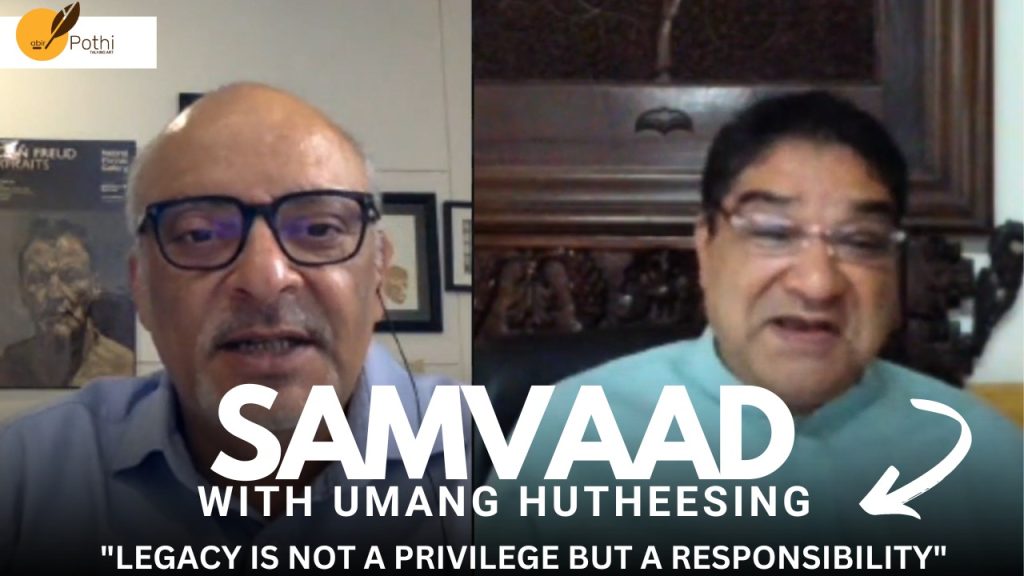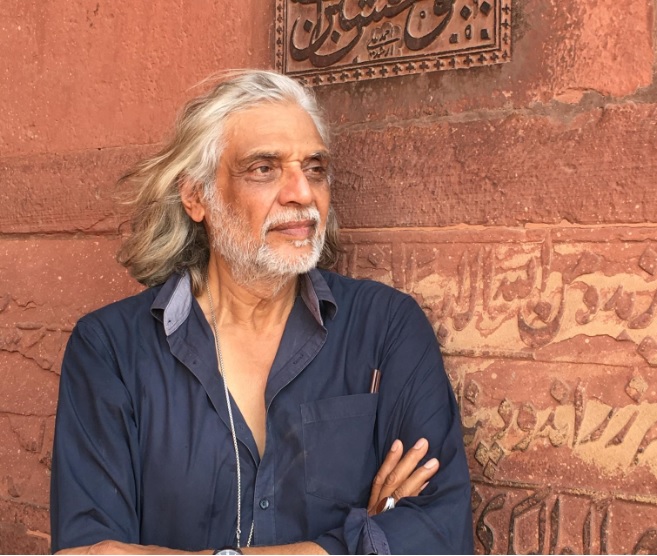Welcome to Samvaad, where art meets conversation, and inspiration knows no bounds. Here we engage in insightful conversations with eminent personalities from the art fraternity. Through Samvaad, Abir Pothi aims to create a platform for thought-provoking discussions, providing readers with an exclusive glimpse into the creative processes, inspirations, and experiences of these creative individuals. From curating groundbreaking exhibitions to pushing the boundaries of artistic expression, our interviews shed light on the diverse perspectives and contributions of these art luminaries. Samvaad is your ticket to connect with the visionaries who breathe life into the art world, offering unique insights and behind-the-scenes glimpses into their fascinating journeys.
This is part 3 of the Samvaad between Nidheesh Tyagi from Abir and Umang Hutheesing, the founder and president of the Hutheesing heritage foundation. Umang Hutheesing is on the governing board of the Ahmedabad Education Society, a managing trustee of the Hutheesing Visual Art Centre, and most importantly is the president and fifth generation of Hutheesing to manage the Hutheesing Design Company and Studio from the very same historic location, Jaising bhai-ni-wadi. He is also the founder and president of the Hutheesing heritage foundation which has restored the Hutheesing Haveli and preserves the Hutheesing art collection. He has collaborated with the international foundation Musée Yves Saint Laurent in Paris and the National Museum of Bahrain, the Baroque Museum in Mexico, the Miho Museum in Japan, and the Chhatrapati Shivaji Vaastu Sangrahalya in Mumbai, where he has exhibited over 300 pieces showcasing the cultural heritage designed by him from the Hutheesing collection.
Nidheesh: yeah. So tell me about your journey in design and having balanced all this legacy.
Umang: well, I am a product of pre-internet. Let us put it that way. Pre-internet and pre-email.
Nidheesh: we are like digital converts and not digital natives.
Umang: exactly. So, I went to America to study in 1984, and I did my undergraduate there at Babson. After graduation, and at that time, the knowledge was very restricted to direct access. And even when I travelled by sea as a young teenager at 18–19 years old, my exposure to Indian classics and history was very good but not to contemporary world history and art. I knew little but not much. So, my godfather, Anand Saheb, my uncle and godfather, was an amazing man. Was exposed to wonderful people of art. And through him, I got to meet fabulous artists. From Rosenberg to Jim Jasper, and even Jackson Pollock, opened my eyes, and I met Andy Warhol too. So, I’ve spent decent time with these artists, in their studios, in Southampton, Easthampton, every summer. So, this was my exposure to the world of International art and design, and it brought a full circle after graduation from Boston, New York because of the association with the Metropolitan Museum of Art, their director, and curators together we explored and researched a lot of the products in their collection are by my family and that’s what a great dialogue of European art, Indian Art, European Design, Indian Design, and how we all, I mean at the end of the day, what are the beautiful things?
Well, beauty is different in different cultures. That taught me a lot. My masters in Japan and I also trained under Harey Wilston for jewellery design and interned with David Hockney for art. I did all of these works which gave me exposure to contemporary art. There I found the difference between Indian Classical Miniature and Reneau or money or Matisse. And I had this privilege, I knew the Picasso family very much, I stayed with them and understood Picasso’s journey from classical art, and you know one can do any abstract art and say its art, no it’s not true. Even Picasso and others were the great masters of classical art and only when they mastered it that they could create something as a new language in art, and it was also with great focus. I mean, for example, Picasso’s cubism started from his understanding of an African mask. There’s a great story around it. So, art is just not a technique, but it is also a lot of thought processes. That technique represents it in execution. So, all this was my exposure to the West.
Nidheesh: and then you came back.
Umang: yes. I came back. As I said, my heart is very Indian. So, you know like the migratory bird I may go anywhere and create, but when the winters come, I always come back home. This is where my nest is. I came back and that was the period when I started looking at art in India, with a new focus. Education gives exposure, it enlightens your mind, and you see things with a new focus.
Nidheesh: yeah
Umang: and I started seeing what we have in our collection. In fact, Raja Ravi Verma came and stayed with my ancestors in Hutheesong Haveli and Tagore also stayed at Hutheesing Haveli and even the first solo show of M.F. Hussain happened at Hutheesing Centre. So, there’s a continuation of the tradition of art.
Nidheesh: which itself is a huge thing to do by the way. I mean in itself is a very all-consuming kind of responsibility you’ve taken.
Umang: yes. These are not collections, and we do have a lot in our collection. Some of them are very important and are not bought as investments, but bought and collected to support artists. Over the last 80 years or 100 years, it became valuable. Our focus for buying was not investment but to support them. And that is why we have Hutheesing visual arts centre built as a sister institution of Santiniketan, it is its 45th year. My grandfather’s sister was married to the Tagore family, which was the first student of Gujarat into Santiniketan.
There’s a wonderful article written about her, she was the favourite student of Rabindranath Tagore, and she married his nephew Saumyendranth Tagore who was the chancellor of Kala Bhawan, and so we have beautiful two hundred pieces from Bengal school and I started looking at that with different perspectives. And then as I got involved with the Hutheesing art centre as a patron but not a collector, as a trustee. It put me with a lot of younger artists, well, the new-age artists. I realized that a lot of young Indian artists today have access to internet entities to learn. By saying young artist, I don’t mean age young but by practice. Young practice. Anywhere in India today, they have access to see what, even films that are documented on various artists across the world. Whether it is a Japanese artist’s brush painting or European masters. And therefore, why I like Abir, coming to that, Oh you start asking me the question and I’ll answer.
Transcribed By Abhishek Dixit.






